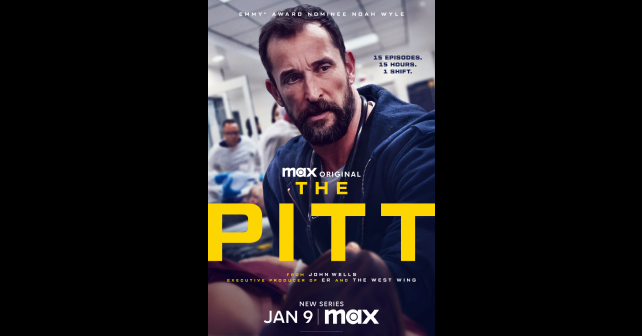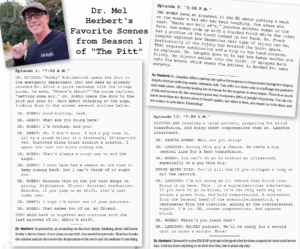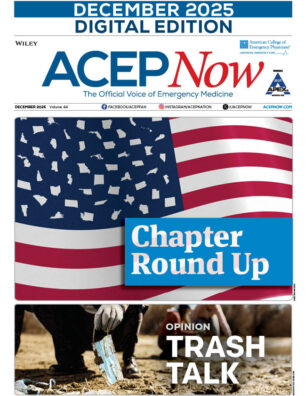
When a viewer sent a message saying they sought help for post-traumatic stress disorder (PTSD) after watching an episode of “The Pitt,” Joe Sachs, MD, FACEP, knew he was accomplishing something far beyond entertainment. For Dr. Sachs—a practicing emergency physician and executive producer of the Max original series—the comment underscored what he’s been working toward for decades: using scripted television to tell deeply human stories that double as public health education.
Explore This Issue
ACEP Now: July 2025Dr. Sachs’ initial goal was to find a more effective way to educate the public beyond public service announcements and flyers. With “The Pitt,” he is taking “public health education” to a level and scale that he once thought impossible.
Audiences are responding. From first-year medical students to residents and attending physicians in emergency medicine, the show has sparked discussion, driven empathy, and even influenced real-time clinical decision-making. One clinician shared that she recognized a rare diagnosis described in a case presented in Episode 14. Another emergency physician said the show captured their experience during COVID-19 better than any documentary ever could.
This is more than entertainment. This is education with a heartbeat.
From Trauma Bays to TV Scripts
Long before Dr. Sachs was rewriting the rules of public health education for television, he was charting a path that bridged science and storytelling. While studying at Stanford University School of Medicine, Dr. Sachs also pursued a master’s degree in filmmaking—an unusual combination that turned out to be prescient. After completing a combined residency in emergency medicine and internal medicine at UCLA, he began a part-time emergency medicine practice at Northridge Hospital Medical Center, Los Angeles, where he has worked for more than 30 years.
Dr. Sachs’ foray into Hollywood started in 1994 when he joined NBC’s “ER” as a technical advisor. He stayed with the groundbreaking series for its entire 15-season run, ultimately becoming executive producer and penning 35 episodes. He later worked on “Mercy, Off the Map,” and “NCIS: Los Angeles” before helping launch “The Pitt” in 2023.
Despite a rigorous production schedule—nine 12-hour days for a single 45-minute episode—Dr. Sachs remains grounded in medicine. He continues to work in urgent-care settings to maintain his clinical edge and gather real-world inspiration.
“Emergency medicine isn’t a hobby for me,” Dr. Sachs said. “It’s a passion. It feeds the creative process and keeps our stories authentic.”
The Power of Realism
Unlike the fast-paced, idealized drama of “ER,” “The Pitt” presents a more raw and contemporary view of a U.S. emergency department (ED). It’s been described as gritty, chaotic, and honest.
“We wanted to show the real issues: the boarding crisis, the pressure of waiting room medicine, the amazing teachers during rounds,” Dr. Sachs said.

Behind the scenes with the creative minds of “The Pitt”: where medicine meets storytelling to educate, inspire, and heal. Dr. Joe Sachs is seated in the center with a hat. Standing in the second row, far right, is Noah Wyle, who plays Dr. Michael “Robby” Robinavitch. (Click to enlarge.)
To achieve that level of realism, the production brings in residency- trained, board-certified emergency physicians as technical advisors. These doctors undergo a 200-hour training session led by Sachs himself, and the show writers receive extensive medical briefings—up to 20 pages per episode. The goal is to get every detail right, from terminology to trauma choreography.
Their efforts are paying off. One viewer, an ED nurse, wrote, “OMG, this is the first medical show I can actually watch.”
Another episode, focused on the emotional strain of boarding, led to a moment of real-life empathy: A patient hugged their physician after watching “The Pitt,” saying they finally understood why the ED felt so overwhelmed.
When Fiction Heals
Dr. Sachs discovered that using entertainment and realistic storytelling is a surprisingly effective way to convey health messages. “The Pitt” has become an unintentional case study in effective health communication, offering scenarios that mirror everyday challenges for physicians and patients alike.
An episode involving a 90-year-old patient facing difficult end-of-life decisions prompted a viewer to approach their own family’s care with new clarity. Another showcased a physician with PTSD from the COVID-19 pandemic, resonating with many health care workers still processing that trauma.
“We’re not just educating the public,” Dr. Sachs noted. “We’re educating physicians too, reminding them they’re not alone in their experiences.”
Noah Wyle, who starred in both “ER” and “The Pitt,” has heard from fans who entered the medical field because of their exposure to “ER.” Dr. Sachs said he hopes “The Pitt” can have a similar, if not more profound, long-term impact. After the COVID- 19 pandemic, emergency medicine residencies had more openings than ever before. However, in the last year, interest has rebounded, and there is no longer a lack of interest.
Public Health Messaging Needs More Artists
Dr. Sachs believes that to truly move the needle on public health understanding, the medical community must embrace more creative avenues. “The Pitt” doesn’t replace peer-reviewed journals or continuing medical education courses. Instead, it fills a different need—connecting with the public and professionals on emotional and empathetic levels.
That’s why Dr. Sachs and his team obsess over accuracy, but the primary goal is entertainment. The makeup department creates prosthetics so convincing that some viewers worried about HIPAA violations. Camera movements are choreographed to mimic the kinetic energy of a busy ED. This dedication stems from Sachs’ belief that the ED is the last true safety net in U.S. health care—a place worthy of respect, advocacy, and accurate portrayal.
“In a time when cuts to Medicaid and Medicare threaten that safety net, we need the public to understand what’s at stake,” Dr. Sachs said.
In short, Dr. Sachs is proof that the intersection of medicine and media doesn’t have to be shallow or sensational. When done right, it can save lives, shape perceptions, and rekindle purpose. With “The Pitt,” Dr. Sachs has created more than a medical drama. He’s helped build a public health classroom—one compelling, pulse-pounding episode at a time.
Leona Scott is a freelance journalist based in Dallas, Texas.
Pages: 1 2 3 4 | Multi-Page







No Responses to “Dr. Joe Sachs and “The Pitt” Redefine Public Health Education Through Storytelling”